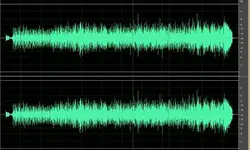M
mikew
New member
Hi all,
Quick question about the initial mixdown of my waveform here. I think I have the mix pretty good except for the bass and cello competing but when I did my first mixdown on this project of ours, I noticed the bottom wave and top wave are not equal. I did some reading and apparently the bottom half of the wave is the lack of pressure in a wave and the top part is the increase in pressure. This does not translate well in my brain when looking at it in the program though. Is it a phase problem? The parts it happens on are large cymbal crashes. I recorded with two overhead mics, one on the snare, one on the high and low tom and one on the kick. Here is a my mixdown wave:
Quick question about the initial mixdown of my waveform here. I think I have the mix pretty good except for the bass and cello competing but when I did my first mixdown on this project of ours, I noticed the bottom wave and top wave are not equal. I did some reading and apparently the bottom half of the wave is the lack of pressure in a wave and the top part is the increase in pressure. This does not translate well in my brain when looking at it in the program though. Is it a phase problem? The parts it happens on are large cymbal crashes. I recorded with two overhead mics, one on the snare, one on the high and low tom and one on the kick. Here is a my mixdown wave:

